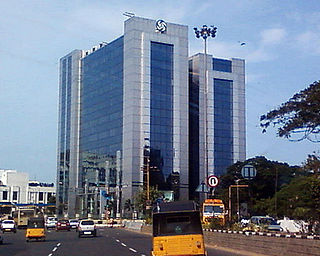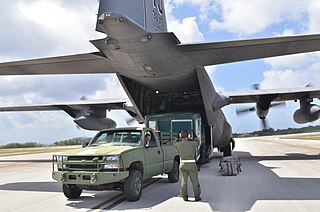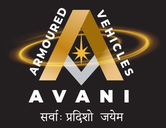
Ashok Leyland is an Indian multinational automotive manufacturer, headquartered in Chennai. It is owned by the Hinduja Group. It was founded in 1948 as Ashok Motors and became Ashok Leyland in the year 1955. Ashok Leyland is the second-largest manufacturer of commercial vehicles in India, the third-largest manufacturer of buses in the world, and the tenth-largest manufacturers of trucks.

The Tata Safari is a mid-size SUV produced by the Indian automobile manufacturer Tata Motors since 1998. The first-generation Safari has been designed as a seven-seater SUV with a foldable third row, roomy interior; on the market it has positioned itself as an alternative from the competitive price to other brands off-road vehicles.

The Studebaker US6 (G630) was a series of 2+1⁄2-ton 6×6 and 5-ton 6×4 trucks manufactured by the Studebaker Corporation and REO Motor Car Company during World War II. The basic cargo version was designed to transport a 2+1⁄2-short-ton cargo load over any type of terrain in any weather. Most of these were exported to the Soviet Union under Lend-Lease by the USA during World War II, since the competing GMC 6×6 CCKW design proved to be more suitable for Western Front conditions.
Bedford Vehicles, usually shortened to just Bedford, was a brand of vehicle manufactured by Vauxhall Motors, then a subsidiary of multinational corporation General Motors. Established in April 1931, Bedford Vehicles was set up to build commercial vehicles. The company was a leading international lorry brand, with substantial export sales of light, medium, and heavy lorries throughout the world.

BMC is one of the largest commercial and military vehicle manufacturers in Turkey. Its products include commercial trucks, buses, military trucks and armoured vehicles. The company was founded in 1964 with 26% partnership of UK's British Motor Corporation. It was taken over by Çukurova Holding of Turkey in 1989, and seized by the Turkish government's TMSF in 2013. BMC has been taken over with a final bid of TL 751M, by a partnership of 51% Turkish side and 49% Qatari side.

Barreiros was a Spanish manufacturer of engines, trucks, buses and automobiles. It was a Chrysler Europe subsidiary from 1969 to 1978.
Ordnance Factory Board (OFB), consisting of the Indian Ordnance Factories, now known as Directorate of Ordnance was an organisation, under the Department of Defence Production (DDP) of Ministry of Defence (MoD), Government of India. The 41 Indian Ordnance Factories have been converted into 7 Defence Public Sector Undertakings (DPSUs).

The Commercial Utility Cargo Vehicle (CUCV) is a vehicle program instituted to provide the United States military with light utility vehicles based on civilian trucks.
Vehicle Research and Development Establishment (VRDE) is a laboratory of the Defence Research & Development Organization (DRDO) located at Vahannagar near Ahmednagar. Its primary function is research and development of various light tracked, wheeled and specialised vehicles for defence applications.

The economy of Madhya Pradesh refers to the economic growth with respect to the Indian state of Madhya Pradesh. It grew 12% in GDP for the year of 2011–12, for which it received an award from then President Pranab Mukherjee in January 2013 for improving its tourism, medical and infrastructural growth. The economy of Madhya Pradesh is significantly agrarian which is reflecting rapid strides towards industrial and service sectors as well. The Indore,Bhopal and Jabalpur districts are the top 3 districts in the state's larger economy.

Canadian Military Pattern (CMP) trucks were mutually coherent ranges of military trucks, made in large numbers, in several classes and numerous versions, by Canada's branches of the U.S. 'Big Three' auto-makers during World War II, compliant to British Army specifications, primarily intended for use in the armies of the British Commonwealth allies, but also serving in other units of the British Empire.

The GMC CCKW, also known as "Jimmy", or the G-508 by its Ordnance Supply Catalog nr, was a highly successful series of off-road capable, 21⁄2-ton, 6×6 trucks, built in large numbers to a standardized design for the U.S. Army, that saw heavy service, predominantly as cargo trucks, in both World War II and the Korean War. The original "Deuce and a Half", it formed the backbone of the famed Red Ball Express that kept Allied armies supplied as they pushed eastward after the Normandy invasion.

The Dodge WC series, sometimes nicknamed 'Beeps', were a prolific range of light 4WD and medium 6WD military utility trucks, produced by Dodge / Fargo during World War II. Together with the 1⁄4-ton jeeps produced by Willys and Ford, the Dodge 1⁄2‑tons and 3⁄4‑tons made up nearly all of the light 4WD trucks supplied to the U.S. military in WWII – with Dodge contributing some 337,500 4WD units.
The Lancia Ro, Lancia Ro-Ro and Lancia 3Ro were 4x2 heavy trucks built by Italian manufacturer Lancia from the 1930s through the 1940s for military and civilian use. The 2-cylinder diesel Ro was produced from 1933 to 1939, the 3-cylinder diesel Ro-Ro from 1935 to 1939 and the improved 5-cylinder diesel 3Ro from 1938 to 1947.

The Stallion range of trucks is produced by Vehicle Factory Jabalpur (VFJ) of Armoured Vehicles Nigam Limited for the Indian Armed Forces.
Vehicle Factory Jabalpur, is a military motor vehicle factory, located in Jabalpur, Madhya Pradesh, India, part of Armoured Vehicles Nigam Limited which was previously a part of Ordnance Factory Board, controlled by the Ministry of Defence, Government of India.

Ordnance Factory Medak (OFMK), previously called Ordnance Factory Project Medak (OFPM) while in its development stage, is a factory owned by Armoured Vehicles Nigam Limited, a company that manufactures armoured vehicles and was one of the 41 Indian Ordnance Factories under the erstwhile Ordnance Factories Board of the Ministry of Defence controlled by Government of India. It is spread over an area of 3023 acres and has an employee strength of about 3000 personnel. The company is headed only by an IOFS officer called General Manager who is the Chief Executive Officer responsible for the overall management of the company and is the main judicial authority. OFMK is the only manufacturer of Infantry Combat Vehicles (ICVs) in India.

The 2+1⁄2-ton, 6×6 truck was a standard class of medium duty trucks, designed at the beginning of World War II for the US Armed Forces, in service for over half a century, from 1940 into the 1990s. Also frequently known as the deuce and a half, or just deuce, this nickname was popularized post WWII, likely in the Vietnam war era. The basic cargo versions were designed to transport a cargo load of nominally 2+1⁄2 short tons over all terrain, in all weather. The 2+1⁄2-ton trucks were used ubiquitously in World War II, and continued to be the U.S. standard medium duty truck class after the war, including wide usage in the Korean and Vietnam Wars, as well as the first Gulf War.

The Ordnance Factory Board Mine Protected Vehicle is a Mine-Resistant Ambush Protected-type vehicle used by the Indian Army and the Central Reserve Police Force as an armored personnel carrier to transport personnel with protections from explosives and small arms fire. The MPV’s construction was based on the Casspir Mk II, which India used in the 1990s.

Armoured Vehicles Nigam Limited (AVANI) is an Indian Public Sector Undertaking defence company, headquartered in Avadi, Chennai, India established in 2021 as part of the restructuring and corporatisation of the Ordnance Factory Board into seven different Public Sector Undertakings. AVANI primarily manufactures Armoured fighting vehicles, Main battle tanks and their engines for the use of the Indian Armed Forces and foreign militaries.















